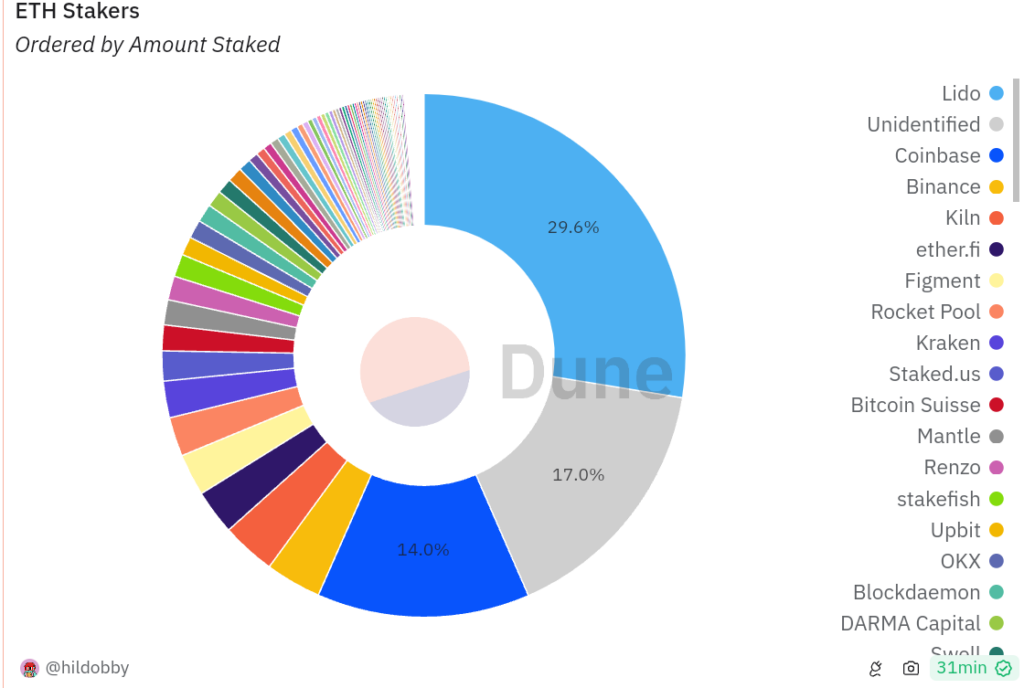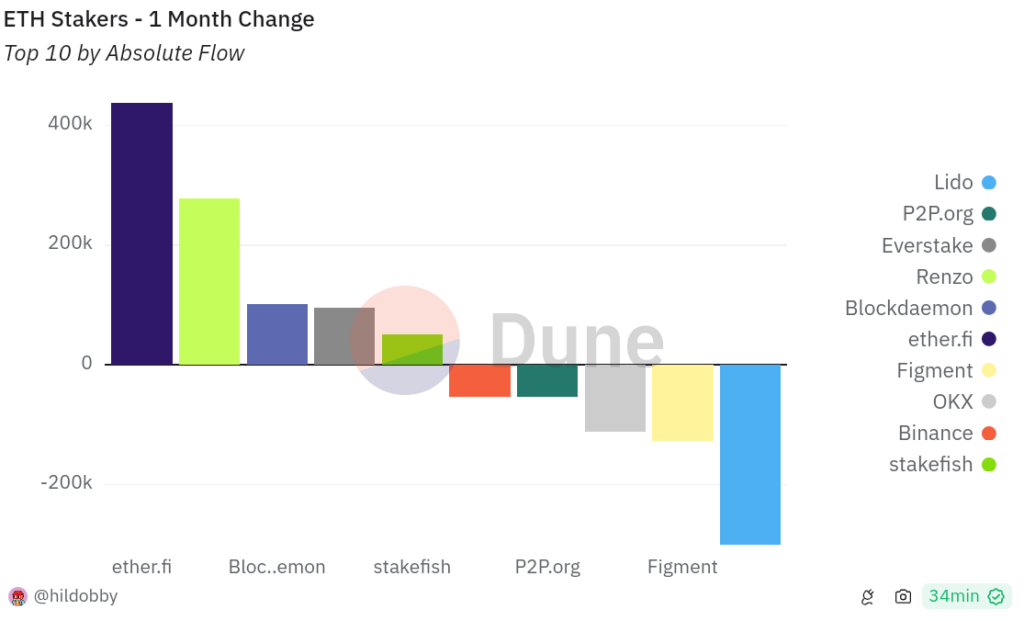LUCKNOW (CoinChapter.com) — Lido, the leading Ethereum liquid staking solution, has seen its market share in ETH staking drop below 30% amid increasing competition. According to data from Dune Analytics, Lido’s Ethereum staking market share fell to 29.57% as of April 4, 2024, down from 32% in December 2023. This decline alleviates concerns about Lido’s growing influence on the Ethereum ecosystem.

Certainly, while Lido remains a prominent player, other entities are gaining ground in the Ethereum staking arena. Crypto exchanges Coinbase and Binance hold 14.04% and 3.75% of the staked ETH market share, respectively. Additionally, the Ethereum staking platform Kiln accounts for 3.5% of the market.

Notably, the second-largest entity in ETH staking remains unidentified, representing 16.9% of the market. In total, 26 known entities contribute to Ethereum staking, including exchanges like Kraken (2.4%), Bitcoin Suisse (1.6%), OKX (1.2%), and Upbit (1.1%).
Lido’s Ethereum Staking: Decentralization Concerns and Solutions
Notably, Lido’s previous dominance in Ethereum staking raised concerns within the Ethereum community, as any entity controlling over 33% of the market could potentially influence various aspects of the Ethereum chain. To address this issue, Ethereum co-founder Vitalik Buterin suggested that stake pools should not exceed 15% control and should adjust their fee rates to remain below this threshold.
In May 2022, the Lido DAO community proposed a hard limit to solve the ETH staking dominance problem. However, the proposal was rejected with a 99.81% vote in June 2022.

Ether fi and Renzo Protocol Steal the Spotlight
Interestingly, the flow of Ethereum stakers is moving towards platforms that offer liquid restaking options. Among these platforms, Ether fi and Renzo Protocol have seen a significant influx of stakers. Ether fi has received over 400,000 staked Ether, while Renzo Protocol has received over 280,100 staked Ether.

Ether fi boasts a total value locked (TVL) of $3.1 billion, while investments in Renzo Protocol have exceeded $2.1 billion. In total, users have locked over $8 billion across these protocols.
The shift of Ethereum staking from Lido to platforms like Ether fi and Renzo highlights the increasing popularity of Eigenlayer’s solutions. These liquid restaking protocols utilize the Eigenlayer framework. This allows Ethereum stakers to participate in other networks and solutions while staking their ETH.
Moreover, the adoption of flexible staking solutions gained momentum after Ethereum’s transition to a proof-of-stake consensus mechanism in September 2022. Certainly, Eigenlayer’s approach, facilitating the staking of ETH across multiple platforms, has resonated with the Ethereum community. It has driven the growth of liquid restaking protocols like Ether fi and Renzo.
Risks and Opportunities in Ethereum Restaking
In addition, as competition in the ETH staking market intensifies, the issuance of liquid restaking tokens (LRTs) has emerged as a potential risk. According to a recent Coinbase report, restaking protocols like Eigenlayer could compound risks by allocating the same funds to similar validators for increased yield.
The report warns that restaking can increase earnings. However, LRTs may be incentivized to maximize yields at the cost of a higher, albeit hidden, risk profile.
As such, LRTs may be incentivized to maximize their yields in order to gain market share, but these could come at the cost of a higher (albeit hidden) risk profile.
Coinbase in-house analysts said.
The post Lido’s Ethereum Staking Market Share Plunges Below 30% appeared first on CoinChapter.







